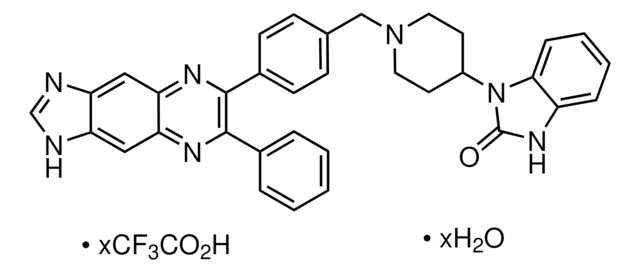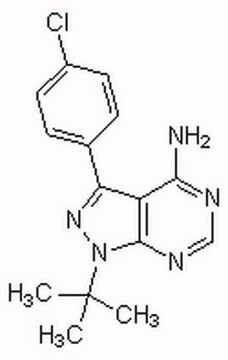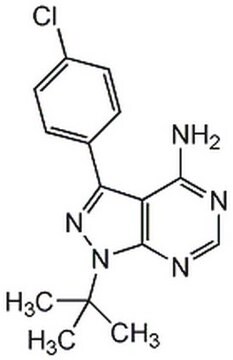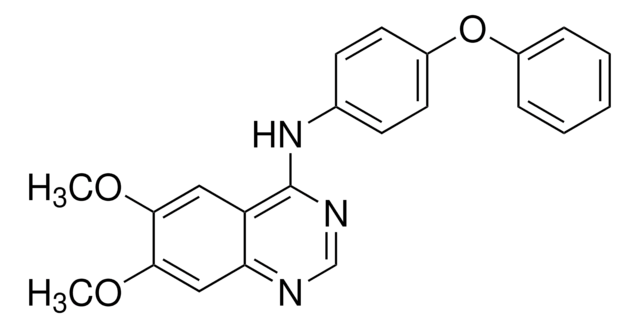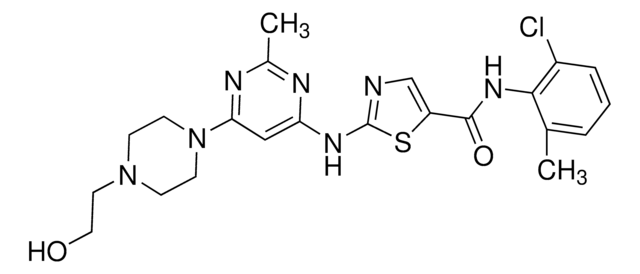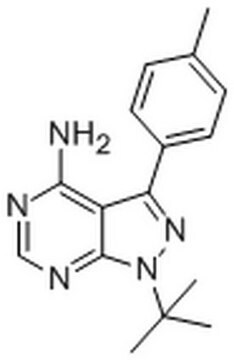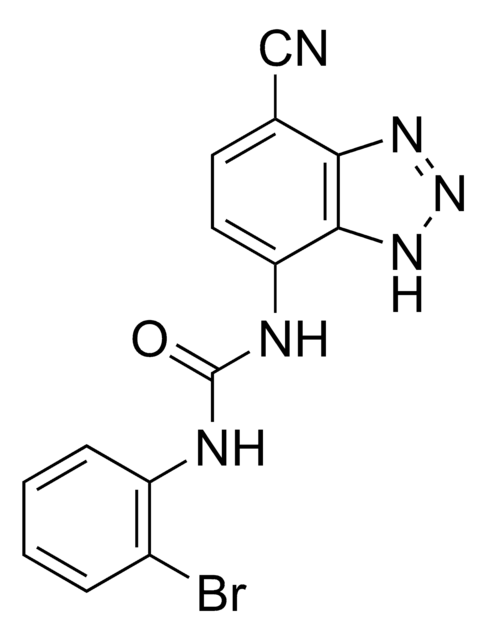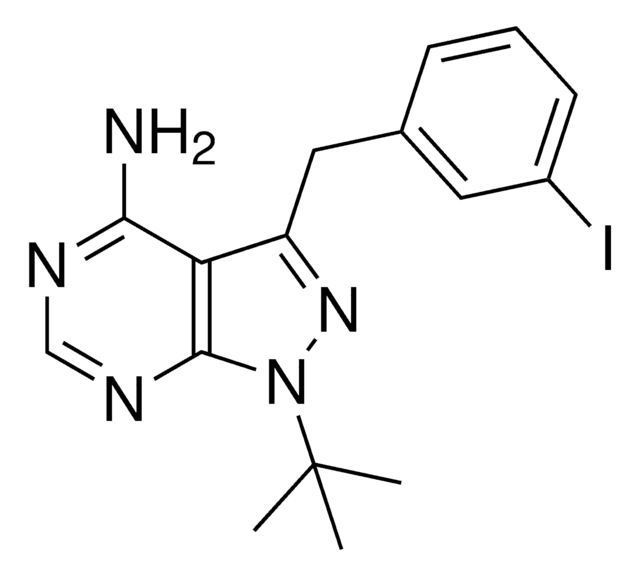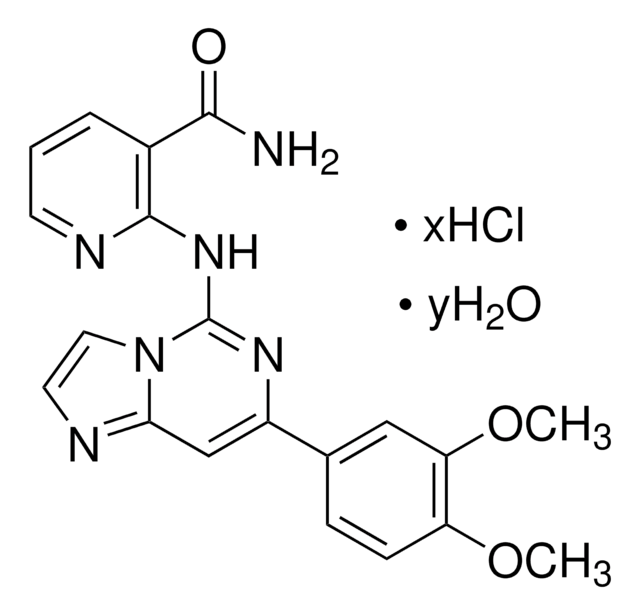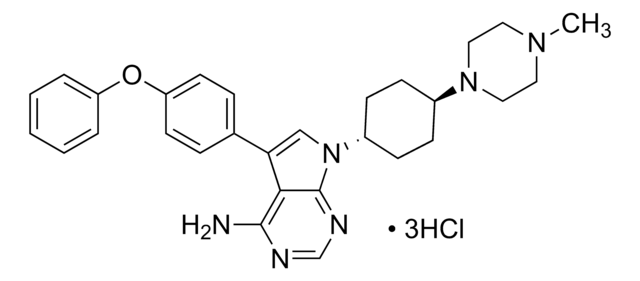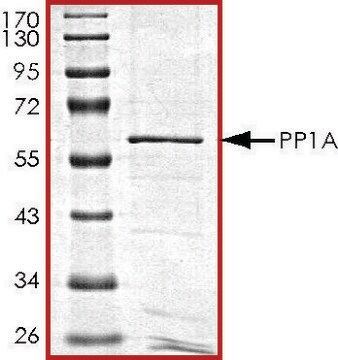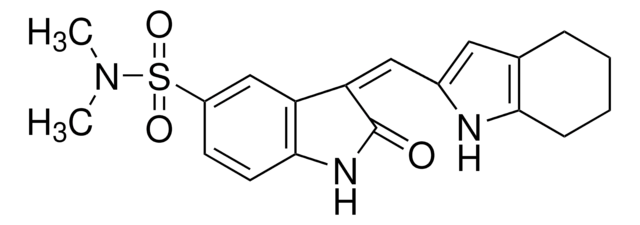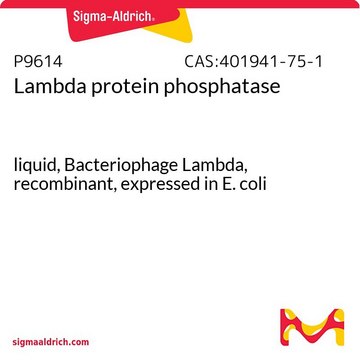P0040
PP1
≥98% (HPLC)
Synonym(s):
4-Amino-5-(methylphenyl)-7-(t-butyl)pyrazolo-(3,4-d)pyrimidine
Sign Into View Organizational & Contract Pricing
All Photos(1)
About This Item
Empirical Formula (Hill Notation):
C16H19N5
CAS Number:
Molecular Weight:
281.36
MDL number:
UNSPSC Code:
12352200
PubChem Substance ID:
NACRES:
NA.77
Recommended Products
Quality Level
Assay
≥98% (HPLC)
form
powder
color
white to off-white
solubility
DMSO: >20 mg/mL
storage temp.
room temp
SMILES string
Cc1ccc(cc1)-c2nn(c3ncnc(N)c23)C(C)(C)C
InChI
1S/C16H19N5/c1-10-5-7-11(8-6-10)13-12-14(17)18-9-19-15(12)21(20-13)16(2,3)4/h5-9H,1-4H3,(H2,17,18,19)
InChI key
ZVPDNRVYHLRXLX-UHFFFAOYSA-N
Application
PP1 has been used as:
- an inhibitor of sarcoma (Src) family kinases (SFK) like hematopoietic cell kinase (hck) and fyn
- a selective Src tyrosine kinase inhibitor in hippocampal neuronal cultures to test its effect on neurite growth
- a Src-kinase blocker to test its effect on brimonidine (BMD)-induced phosphorylation in extracellular signal-activated kinases(ERK1/2)
Biochem/physiol Actions
PP1 is a pyrazolopyrimidine compound that acts as a competitive inhibitor of adenosine triphosphate (ATP) binding. It also inhibits protein tyrosine kinase (PTK6) and may be useful in the therapeutic management of PTK6 positive based breast cancer malignancy.
PP1 is a potent and selective Src family protein tyrosine kinase inhibitor.
Features and Benefits
This compound is a featured product for Kinase Phosphatase Biology research. Click here to discover more featured Kinase Phosphatase Biology products. Learn more about bioactive small molecules for other areas of research at sigma.com/discover-bsm.
Storage Class Code
11 - Combustible Solids
WGK
WGK 3
Flash Point(F)
Not applicable
Flash Point(C)
Not applicable
Choose from one of the most recent versions:
Already Own This Product?
Find documentation for the products that you have recently purchased in the Document Library.
Customers Also Viewed
Qian Wang et al.
Environmental science and pollution research international, 26(21), 21774-21783 (2019-05-28)
Due to variable amino acid residues at positions 2 and 4, microcystins (MCs) had diversified variants with different toxicities. To evaluate the discrepant toxicity, the inhibition effects of five typical MC variants (with the changed amino acid residues at position
Katyayni Vinnakota et al.
Journal of cellular physiology, 232(12), 3468-3480 (2017-01-18)
The inflammatory milieu plays an important role in colon cancer development and progression. Previously, we have shown that tumor-associated macrophages (TAMs), an important component of the tumor microenvironment, are enriched in tumors compared with normal tissue and confer a poorer
Shunyu Gao et al.
General and comparative endocrinology, 240, 46-60 (2016-10-23)
Neuropeptide Y (NPY) receptors and its ligands, NPY, peptide YY (PYY) and pancreatic polypeptide (PP), are suggested to regulate many physiological processes including food intake in birds. However, our knowledge regarding this avian NPY system remains rather limited. Here, we
Xiaotong Zhu et al.
International journal for parasitology, 49(9), 685-695 (2019-06-17)
Sexual development in malaria parasites involves multiple signal transduction pathways mediated by reversible protein phosphorylation. Here, we functionally characterised a protein phosphatase, Ser/Thr protein phosphatase 5 (PbPP5), during sexual development of the rodent malaria parasite Plasmodium berghei. The recombinant protein
Jun Mori et al.
Blood, 131(10), 1122-1144 (2018-01-06)
Src family kinases (SFKs) coordinate the initiating and propagating activation signals in platelets, but it remains unclear how they are regulated. Here, we show that ablation of C-terminal Src kinase (Csk) and receptor-like protein tyrosine-phosphatase CD148 in mice results in
Related Content
Discover Bioactive Small Molecules for Kinase Phosphatase Biology
Our team of scientists has experience in all areas of research including Life Science, Material Science, Chemical Synthesis, Chromatography, Analytical and many others.
Contact Technical Service